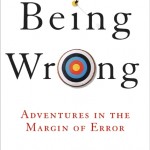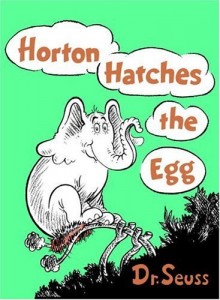I haven’t had a chance to get back to my blog mash-up series for over a week now. I have been thinking a lot about it, but not necessarily in productive ways—maybe I am letting it simmer too long. Honestly, I have spent the past few hours (and some of yesterday too) trying to figure out what to write and where to go with it. The kids are out of school and I started another blog project with STA. I am also struggling a little as I try to negotiate the different writing styles required for blogs and academic journals. Oh well.
 I am now taking a break from it for the rest of the day. Time for some fun writing. A few days ago I purchased my very first iBook for the iPad: Being Wrong: Adventures in the Margin of Error by Kathryn Schulz. I found out about this book in a New York Times review. I was drawn to it because of my serious interest in troublemaking (and the trouble that being wrong and failing to be right causes). To me, being wrong seems a lot like being uncertain, which is also a lot like staying in trouble. To be wrong is also to come up against one’s limits of knowing what to do or how to do it. This reminds me of Foucault and his discussion of the limit attitude in “What is Enlightenment?” Now, I don’t think Foucault would describe this as being wrong, which seems to be a judgment, always made in relation to its opposite: being right. However, I think Schulz’s ideas about the value of wrongness do share some similarities with Foucault and his promotion of limits and problematization (or problem posing). But, in the interest of keeping this entry on the light side, I won’t get into those similarities right now. I am trying to work on the value of problem posing in relation to repair and care for my mash-up and I am still struggling with it.
I am now taking a break from it for the rest of the day. Time for some fun writing. A few days ago I purchased my very first iBook for the iPad: Being Wrong: Adventures in the Margin of Error by Kathryn Schulz. I found out about this book in a New York Times review. I was drawn to it because of my serious interest in troublemaking (and the trouble that being wrong and failing to be right causes). To me, being wrong seems a lot like being uncertain, which is also a lot like staying in trouble. To be wrong is also to come up against one’s limits of knowing what to do or how to do it. This reminds me of Foucault and his discussion of the limit attitude in “What is Enlightenment?” Now, I don’t think Foucault would describe this as being wrong, which seems to be a judgment, always made in relation to its opposite: being right. However, I think Schulz’s ideas about the value of wrongness do share some similarities with Foucault and his promotion of limits and problematization (or problem posing). But, in the interest of keeping this entry on the light side, I won’t get into those similarities right now. I am trying to work on the value of problem posing in relation to repair and care for my mash-up and I am still struggling with it.
Check out a few passages from the book (and what I have read so far) on:
the value of being wrong
Of all the things we are wrong about, this idea of error [as failure] might well top the list. It is our meta-mistake: we are wrong about what it means to be wrong. Far from being a sign of intellectual inferiority, the capacity to err is crucial to human cognition. Far from being a moral flaw, it is inextricable from some of our most humane and honorable qualities: empathy, imagination, conviction, and courage. And far from being a mark of indifference or intolerance, wrongness is a vital part of how we learn and change. Thanks to error, we can revise our understanding of ourselves and amend our ideas about the world (12, in iBooks version).
the pedagogy of being wrong
…however disorienting, difficult, or humbling our mistakes might be, it is ultimately wrongness, not rightness, that can teach us who we are (12).
the connection between being wrong and imagination
We already say that “seeing the world as it is not” is pretty much the definition of erring–but it is also the essence of imagination, invention and hope. As that suggests, our errors sometimes bear far sweeter fruits than the failure and shame we associate with them. True, they represent a movement of alienation, both from ourselves and from a previously convincing vision of the world. But what’s wrong with that? “To alienate” means to make unfamiliar; and to see things–including ourselves–as unfamiliar is an opportunity to see them anew (35).
So far, I am really enjoying this book. I want to spend some more time thinking about the ways I agree and disagree with her assessment of being wrong. For right now, I am happy to be reading a book that sees value in erring or, as Schulz eloquently puts it, “fucking up.” Cool.
I’m reading this book on my iPad. I really like it. Let me list just a few reasons why:
- It turns the page like a real book. I know everyone mentions this feature. There’s a reason why they do; it’s pretty damn cool. Not only does it look cool, but it feels cool and makes it really easy to flip back and forth between pages. It’s like a “real” book, but better. And much better than kindle books (yes, I have the kindle app too).
- It has a useful bookmark feature. Sure, many people complain about how the bookmark feature doesn’t bookmark anything (unlike the Kindle). Instead, it highlights text. While I agree that calling this feature a bookmark is rather strange, I happen to like that it highlights (and in at least five different colors!). I used it to keep track of the passages that I cited above. I anticipate using this feature a lot during the semester.
- It can download books instantly.
- It lights up so that you can read in bed. I don’t have a bedside lamp right now and I have been lamenting the fact that I can’t read much at night. That is, until now. I can read the iPad all night if I want to (which I don’t) and, if I’m feeling considerate to STA (which I usually am), I can dim the light a little so that I can still read without blinding them. While I have never used a Kindle, I’ve been told (and have read) that it doesn’t have its own light. What’s the point, then?
But, of course, the iPad and iBooks aren’t perfect (not even close. But, if you have been reading this entry you will hopefully recognize that I don’t mind when things fail or when things go wrong). Here are a few things I don’t like:
- As others have suggested, the iBooks selection is pretty pathetic right now, especially for academic books. Does it have any books by Judith Butler? No. Sara Ahmed? No. Jasbir Puar? Yeah, right. Michel Foucault. Just one: Abnormal. If the selection doesn’t change in the next few months, I won’t be using iBooks for my classes at all. Now, the Kindle app for the iPad does have quite a few choices. Several Butler books. One by Ahmed. Tons of Foucault. While I don’t like the Kindle app experience quite as much, I do appreciate their selection of books.
- You can highlight text but you can’t take notes in iBooks. At least, I don’t think you can. I know that you can on the Kindle, but I don’t see how in iBooks. Any iPad users out there?
In reflecting on being wrong, I can’t help but think about failure and the seemingly ubiquitous internet meme, FAIL. I know that this has been around for years, but I have never taken the time to explore its origins or meanings. Thank goodness I don’t have to; youtube as done it for me. Check it out:
Speaking of memes, I must present my own FAIL. I recently posted a clip called “The Dramatic Chipmunk”. Well, I knew it was old and had gone viral some time ago. But I didn’t realize it was three years old or that it was the dramatic prairie dog (okay, I knew it wasn’t a chipmunk; I was torn between thinking it was squirrel or a hamster). My bad (and how old is that phrase?). Here’s a youtube video that exposes my (epic?) fail:

